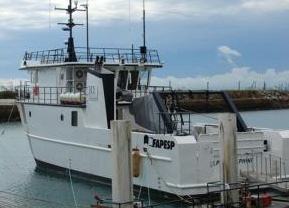

The oceanographic ship was built with the objective of increasing oceanographic research capacity in Brazil
The oceanographic ship was built with the objective of increasing oceanographic research capacity in Brazil.
The oceanographic ship was built with the objective of increasing oceanographic research capacity in Brazil.

The oceanographic ship was built with the objective of increasing oceanographic research capacity in Brazil
By Elton Alisson
Agência FAPESP – The scientific community of São Paulo State has just gained its second new ship for oceanographic research in less than a year. The newest vessel, Alpha Delphini, will begin its first scientific expedition in June.
Built entirely in Brazil, the Alpha Delphini is part of a project that Universidade de São Paulo’s Oceanographic Institute (IO-USP) presented to FAPESP under the auspices of the Multi-user Equipment Program (EMU). It was built with the objective of increasing oceanographic research capacity in the state. The project also included the acquisition of the Alpha Crucis, an oceanographic ship inaugurated in May 2012 that has made seven voyages to date, including research expeditions.
“The two vessels complement each other perfectly in terms of oceanographic research possibilities and were conceived to do so,” commented Michel Michaelovitch de Mahiques, director of IO-USP.
“The Alpha Delphini is autonomous and has an intermediate research capacity somewhere between the small ships and oceanographic vessels available for research in São Paulo State and fulfills a need that we had to have a ship that covered what we call the continental platform – an area that begins from the coastline and extends to a depth of 200 meters,” he explained.
According to Mahiques, the total cost of the ship was R$ 5.5 million. The FAPESP EMU program earmarked R$ 4 million for construction of the ship. The remainder – spent on motors and a series of scientific equipment – was financed with resources from IO-USP.
The ship – given the name of a binary star that orbits the Delphinus (dolphin in Latin) constellation, seen from the Northern Hemisphere – is 26 meters long and has a 10-passenger capacity in addition to the crew. It was built at the Inace shipyard in Ceará.
The boat can sail for 10 to 15 days, depending on the number of crew members, without the need to refuel and can operate throughout its full range, extending 200 nautical miles from the coastal frontier.
“We estimate that the demand for the Alpha Delphini will be greater than that for the Alpha Crucis because the vessel is more appropriate for research on the continental shelf and allows for shorter voyages at a lower cost than those of the oceanographic ship,” compares Mahiques.
According to the researcher, as part of the EMU program the boat can be requested for research at any university, including private institutions. However, the regulation establishes priority for certain cases, such as projects funded by FAPESP and use by IO-USP researchers. Next in line are projects from two other São Paulo universities, Unesp and Unicamp, which have been given preference over others.
“The Alpha Delphini is an oceanographic ship with the ideal characteristics for the majority of research institutions in Brazil because it is mid-sized, has a relatively low cost compared to oceanographic vessels and can allow for studies on the continental platform, for which demand is very large,” estimated Mahiques.
“The vessel also has the symbolic importance of being the first oceanographic ship built in Brazil and shows that national industry has the capability to build research vessels,” he highlighted.
First expedition
The first scientific expedition of the Alpha Delphini is set for June off the Pernambuco coast, between the island of Itamaracá and the archipelago of Fernando de Noronha, beyond the Recife coastal zone.
Slated to last 15 days, the expedition is part of a Thematic Project conducted by IO-USP researchers in partnership with Universidade Federal de Pernambuco (UFPE) and the French National Research Agency (ANR) under the auspices of an agreement between FAPESP and the Pernambuco State Research Foundation (Facepe).
The objective of the expedition is to evaluate the role of oceanic and coastal regions in Pernambuco as carbon absorbers and releasers and to identify which zones act in one way or another.
The bifurcation region of the marine current that comes from Africa and splits – a part of the water mass moving in the direction of Northern Brazil and another to the Southern Region –has always been little known and understood, according to Elisabete de Santis Braga, professor at IO-USP and coordinator of the project.
After the expedition, the Alpha Delphini will travel to São Paulo, where it will be anchored at warehouse number eight in the Port of Santos. During the trip to São Paulo, a new team of researchers, including IO-USP members, will collect data on the carbon cycle.
“We cannot lose the opportunity to collect scientific data while the ship is travelling to São Paulo and to give our students the opportunity to participate in research,” affirmed Braga. The researchers’ idea is that when the ship is not engaged in research, it will remain open to public visitation in the Port of Santos.
Republish
The Agency FAPESP licenses news via Creative Commons (CC-BY-NC-ND) so that they can be republished free of charge and in a simple way by other digital or printed vehicles. Agência FAPESP must be credited as the source of the content being republished and the name of the reporter (if any) must be attributed. Using the HMTL button below allows compliance with these rules, detailed in Digital Republishing Policy FAPESP.





